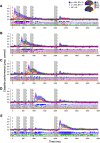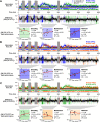Exploring Information Flow from Posteromedial Cortex during Visuospatial Working Memory: A Magnetoencephalography Study
- PMID: 35732493
- PMCID: PMC9337606
- DOI: 10.1523/JNEUROSCI.2129-21.2022
Exploring Information Flow from Posteromedial Cortex during Visuospatial Working Memory: A Magnetoencephalography Study
Abstract
The posteromedial cortex (PMC) is a major hub of the brain's default mode network, and is implicated in a broad range of internally driven cognitions, including visuospatial working memory. However, its precise contribution to these cognitive processes remains unclear. Using MEG, we measured PMC activity in healthy human participants (young adults of both sexes) while they performed a visuospatial working memory task. Multivariate pattern classification analyses revealed stimulus-related information during encoding and retrieval in a set of a priori defined cortical ROIs, including prefrontal, occipital, and ventrotemporal cortices, in addition to PMC. We measured the extent to which this stimulus information was exchanged between areas in an information flow analysis, measuring Granger-causal relationships between areas over time. Consistent with the visual nature of the task, information from occipital cortex shaped other regions across most epochs. However, the PMC shaped object representations in occipital and prefrontal cortices during visuospatial working memory, influencing occipital cortex during retrieval and PFC across all task epochs. Our findings are consistent with a proposed role for the PMC in the representation of internal content, including remembered information, and in the comparison of external stimuli with remembered material.SIGNIFICANCE STATEMENT The human brain operates as a collection of highly interconnected regions. Mapping the function of this interconnectivity, as well as the specializations within different regions, is central to understanding the neural processes underlying cognition. The posteromedial cortex (PMC) is a highly connected cortical region, implicated in visuospatial working memory, although its precise contribution remains unclear. We measured the activity of PMC during a visuospatial working memory task, testing how different regions represented the stimuli, and whether these representations were driven by other cortical regions. We found that PMC influenced stimulus information in other regions across all task phases, suggesting that PMC plays a key role in shaping stimulus representations during visuospatial working memory.
Keywords: MEG; episodic memory; information flow analysis; posterior cingulate cortex; visuospatial memory.
Copyright © 2022 the authors.
Figures






References
-
- Benjamini Y, Hochberg Y (1995) Controlling the false discovery rate: a practical and powerful approach to multiple testing. J R Stat Soc Ser B Methodol 57:289–300. 10.1111/j.2517-6161.1995.tb02031.x - DOI
Publication types
MeSH terms
LinkOut - more resources
Full Text Sources
Miscellaneous
